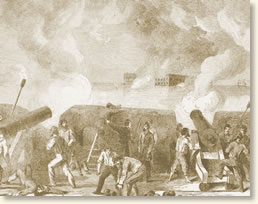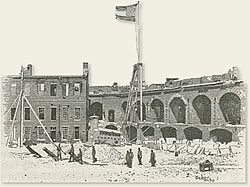|
The First Shot of the Civil War
The Surrender of Fort Sumter, 1861
The election of Abraham Lincoln in November 1860 provoked the secession of the Southern States from the Union. South Carolina was the first to leave. By the time of the convening of a constitutional convention to establish the Confederacy in February 1861, six other states had joined her. The majority of the Southern leaders who attended the convention expected a peaceful secession; they did not anticipate that their action would lead to bloody conflict. They were wrong. Fort Sumter, lying in the harbor off the city of Charleston, South Carolina, would prove the point.

Firing on Fort Sumter
From a contemporary illustration. |
After her secession from the Union, South Carolina perceived herself as a sovereign state - the presence of Union forces in an armed fortress whose guns commanded her principal harbor was intolerable as it belied her independence. For President Lincoln the voluntary abandonment of this fortress was equally intolerable as it would be a tacit acknowledgment of South Carolina's independent status.
Lincoln learned that the garrison at Fort Sumter was in trouble on the day he took office in March 1861. The garrison was running out of food and supplies and had no way of obtaining these on shore. The President ordered a relief expedition to sail immediately and informed the Governor of South Carolina of his decision. Alerted, General P.G.T Beauregard, commander of the Confederate military forces, realized he had to quickly force the evacuation of the fort before the relief expedition's arrival. He would try threats first, and if these failed he would bombard the fort into submission.
On the afternoon of April 11, waving a white flag, two members of General Beauregard's staff were rowed across Charleston's harbor to Fort Sumter carrying a written demand for surrender. One of the emissaries - Stephen D. Lee - wrote of the experience after the war:
"This demand was delivered to Major Anderson at 3:45 P.M., by two aides of General Beauregard, James Chesnut, Jr., and myself. At 4:30 P.M. he handed us his reply, refusing to accede to the demand; but added, 'Gentlemen, if you do not batter the fort to pieces about us, we shall be starved out in a few days.' The reply of Major Anderson was put in General Beauregard's hands at 5:15 P.M., and he was also told of this informal remark. Anderson's reply and remark were communicated to the Confederate authorities at Montgomery. The Secretary of War, L.P. Walker, replied to Beauregard as follows:"
'Do not desire needlessly to bombard Fort Sumter. If Major Anderson will state the time at which, as indicated by him, he will evacuate, and agree that in the meantime he will not use his guns against us, unless ours should be employed against Fort Sumter, you are authorized thus to avoid the effusion of blood. If this, or its equivalent, be refused, reduce the fort as your judgment decides to be most practicable.'
|
"
The same aides bore a second communication to Major Anderson, based on the above instructions, which was placed in, his hands at 12:45 A.M., April 12th. His reply indicated that he would evacuate the fort on the 15th, provided he did not in the meantime receive contradictory instructions from his Government, or additional supplies, but he declined to agree not to open his guns upon the Confederate troops, in the event of any hostile demonstration on their part against his flag. Major Anderson made every possible effort to retain the aides till daylight, making one excuse and then another for not replying. Finally, at 3:15 A.M., he delivered his reply. In accordance with their instructions, the aides read it and, finding it unsatisfactory, gave Major Anderson this notification:"
'FORT SUMTER, S.C., April 12, 1861, 3:20 A.M. - SIR: By authority of Brigadier-General Beauregard, commanding the Provisional Forces of the Confederate States, we have the honor to notify you that he will open the fire of his batteries on Fort Sumter in one hour from this time. We have the honor to be very respectfully, Your obedient servants, JAMES CHESNUT JR., Aide-de-camp. STEPHEN D. LEE, Captain C. S. Army, Aide-de-camp.'
|
"The above note was written in one of the casemates of the fort, and in the presence of Major Anderson and several of his officers. On receiving it, he was much affected. He seemed to realize the full import of the consequences, and the great responsibility of his position. Escorting us to the boat at the wharf, he cordially pressed our hands in farewell, remarking, 'If we never meet in this world again, God grant that we may meet in the next.'
It was then 4 A.M. Captain James at once aroused his command, and arranged to carry out the order. He was a great admirer of Roger A. Pryor, and said to him, 'You are the only man to whom I would give up the honor of firing the first gun of the war'; and he

Fort Sumter after the battle
The Confederate Flag flies above it |
offered to allow him to fire it. Pryor, on receiving the offer, was very much agitated. With a husky voice he said, 'I could not fire the first gun of the war.' His manner was almost similar to that of Major Anderson as we left him a few moments before on the wharf at Fort Sumter. Captain James would allow no one else but himself to fire the gun.
The boat with the aides of General Beauregard left Fort Johnson before arrangements were complete for the firing of the gun, and laid on its oars, about one-third the distance between the fort and Sumter, there to witness the firing of 'the first gun of the war' between the States. It was fired from a ten-inch mortar at 4:30 A.M., April 12th, 1861. Captain James was a skillful officer, and the firing of the shell was a success. It burst immediately over the fort, apparently about one hundred feet above.
The firing of the mortar woke the echoes from every nook and corner of the harbor, and in this the dead hour of the night, before dawn, that shot was a sound of alarm that brought every soldier in the harbor to his feet, and every man, woman and child in the city of Charleston from their beds. A thrill went through the whole city. It was felt that the Rubicon was passed. No one thought of going home; unused as their ears were to the appalling sounds, or the vivid flashes from the batteries, they stood for hours fascinated with horror."
References:
Stephen Lee's account appears in: Buel, Clarence, and Robert U. Johnson, Battles and Leaders of the Civil War, Vol. I (1888, reprinted. 1982); McPherson, James M. Battle Cry of Freedom: The Civil War Era (1988); Niven, John, The Coming of the Civil War 1837-1861 (1990).
How To Cite This Article:
"The First Shot of the Civil War: The Surrender of Fort Sumter, 1861" EyeWitness to History, www.eyewitnesstohistory.com (2006).
|






